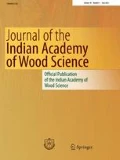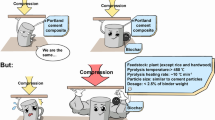Abstract
The water absorption and diffusion properties of wood flour/polymer composites were studied according to the different compositions. We have chosen to work with similar particle size either for the wood flour or for the chosen polymer. Diffusion and absorption of moisture in virgin (WPCv) or recycled (WPCr) composites were carried out at different immersion times in water at ambient temperature. Also, the measurements of absorption, swelling and diffusion coefficients were carried out for all WPC composites at different wood flour contents. The results showed that the response of WPCr to water immersion strongly depends on the content of wood powder. Any increase in wood content leads to an increase in water uptake. CaCO3 additives reduce swelling and water absorption. WPCv expressed higher swelling and water absorption values than WPCr. The highest diffusion coefficients were detected in the composites with a high wood content. The study of water absorption in WPCs has clearly indicated that the process follows kinetics and mechanisms described by Fick’s law. The understanding of water-polymeric composites interactions is achieved through the measurements of static water contact angles on the surfaces of the WPCr by indicating the hydrophobicity of the polymer and hydrophilicity of the wood.






Similar content being viewed by others
References
Adhikary KB (2008) Development of wood flour- recycled polymer composite panels as building materials. Chemical and Process Engineering, University of Canterbury
Adhikary KB, Pang S, Staiger MP (2008a) Dimensional stability and mechanical behaviour ofwood–plastic composites based on recycled and virgin high-density polyethylene (HDPE). Compos Part B Eng 39:807–815
Adhikary KB, Pang S, Staiger MP (2008b) Long-term moisture absorption and thickness swelling behaviour of recycled thermoplastics reinforced with Pinus radiata sawdust. Chem Eng J 142:190–198
Adhikary KB, Pang S, Staiger MP (2008c) Dimensional stability and mechanical behaviour of wood–plastic composites based on recycled and virgin high density polyethylene (HDPE). Compos Part B Eng 39(5):807–815
American Society for Testing and Materials (ASTM) (2002) ASTM D618-99: In: Annual book of ASTM Standards. West Conshohocken
American Society for Testing and Materials (ASTM) (2022). ASTM D570-98: In: Annual book of ASTM Standards. West Conshohocken.
Ayrilmis N, Jarusombuti S (2011) Flat-pressed wood plastic composite as an alternative to conventional wood-based panels. J Compos Mater 45:103–112
Ayrilmis N, Benthien JT, Thoemen H (2012) Effects of formulation variables on surface properties of wood plastic composites. Compos Part B Eng 43(2):325–331
Ayrilmişs N, Benthien JT, Thoemen H (2012) Effects of formulation variables on surface properties of wood plastic composites. Compos Part B Eng 43(2):325–331
Bensalem K, Toubal L, Cuillière JC, François V, Gning PB (2013) Experimental and numerical studies study of hygrothermal aging of a short hemp fibers/polypropylene composite. The 19th international conference on composite materials
BuyuksariU AyrilmisN, Akbulut T (2012) Compression wood as a source of reinforcing filler for thermoplastic composites. J Appl Polym Sci 123:1740–1745
Crank J (1975) The mathematics of diffusion, 2nd edn. Brunel University Uxbridge, Clarendon Press
Dhakal HN, Zhang ZY, Richardson MOW (2007) Effect of water absorption on the mechanical properties of hemp fibre reinforced unsaturated polyester composites. Compos Sci Technol 67:1674–1683
Echeverria CA, Pahlevani F, Sahajwalla V (2020) Valorisation of discarded nonwoven polypropylene as potential matrix-phase for thermoplastic-lignocellulose hybrid material engineered for building applications. J Clean Prod 258:120730
Espert A, Vilaplana F, Karlsson S (2004) Comparison of water absorption in natural cellulosic fibres from wood and one-year crops in polypropylene composites and its influence on their mechanical properties. Compos Part A Appl Sci Manuf 35:1267–76
Faure F, Perrot A, Pimbert S, Lecompte T (2019) Water absorption measurements on WPCs: assessment of size and direction dependencies in order to design fast and accurate quality control tests. Polym Test 77:105899
Grammatikos SA, Zafari B, Evernden MC, Mottram JT, Mitchels JM (2015) Moisture uptake characteristics of a pultruded fibre reinforced polymer flat sheet subjected to hot/wet aging. Polym Degrad Stab. https://doi.org/10.1016/j.polymdegradstab.2015.10.001
Hietala M, Samuelsson E, Niinimäki J, Oksman K (2011) The effect of pre-softened wood chips on wood fibre aspect ratio and mechanical properties of wood–polymer composites. Compos Part A Appl S 42(12):2110–2116
Homkhiew C, Ratanawilai T, Thongruang W (2016) Long-term water absorption and dimensional stability of composites from recycled polypropylene and rubberwood flour. J Thermoplast Compos Mater 29:74–91
Jeamtrakull S, Kositchaiyong A, Markpin T, Rosarpitak V, Sombatsompop N (2012) Effects of wood constituents and content, and glass fiber reinforcement on wear behavior of wood/PVC composites. Compos Part B Eng 43(7):2721–2729
Joannès S, Mazé L, Bunsell AR (2014) Concentration-dependent diffusion coefficient model for water sorption in composite. Compos Struct 108:111–118
Kaboorani A (2017) Characterizing water sorption and diffusion properties of wood/plastic composites as a function of formulation design. Constr Build Mater 136:164–172
Karumuri S, Hiziroglu S, Kalkan AK (2017) The distribution and role of nanoclay in lignocellulose-polymer blends. RSC Adv 7:19406–19416
Lazrak C, Kabouchi B, Hammi M, Famiri A, Ziani M (2019) Structural study of maritime pine wood and recycled high-density polyethylene (HDPE) plastic composite using infrared-ATR spectroscopy, X-ray diffraction, SEM and contact angle measurements. Case Stud Constr Mater 10:e00227
Leu S-Y, Yang T-H, Lo S-F, Yang T-H (2012) Optimized material composition to improve the physical and mechanical properties of extruded wood-plastic composites (WPCs). Constr Build Mater 29:120–127
Li Y (2012) Effect of coupling agent concentration, fiber content, and size on mechanical properties of wood/HDPE composites. Int J Polym Mater 61(11):882–890
Li H, Song K, Zhou D, Wu Q (2014) Effect of durability treatment on moisture sorption properties of wood-plastic composites. Bioresources 9(4):6397–6407
Liang JZ, Wang F (2015) Flexural and impact properties of POM/EVA/HDPE blends and POM/EVA/HDPE/nano-CaCO3 composites. Polym Bull 72:915–929
Lin Q, Zhou X, Dai G (2002a) Effect of hydrothermal environment on moisture absorption and mechanical properties of wood flour–filled polypropylene composites. J Appl Polym Sci 85:2824–2832
Lin Q, Zhou X, Dai G (2002b) Effect of hydrothermal environment on moisture absorption and mechanical properties of wood flour filled polypropylene composites. J Appl Polym Sci 85(14):2824–2832
Mrad H, Alix S, Migneault S, Koubaa A, Perré P (2018) Numerical and experimental assessment of water absorption of wood-polymer composites. Measurement 115:197–203
Panthapulakkal S, Sain M (2007) Injection-molded short hemp fiber/glass fiber-reinforced polypropylene hybrid composites: mechanical, water absorption and thermal properties. J Appl Polym Sci 103:2432–2441
Roy S, Xu W (2001) Modeling of diffusion in the presence of damage in polymer matrix composites. Int J Solids Struct 38:115–126
Sdrobiş A, Darie RN, Totolin M, Cazacu G, Vasile C (2012) Low density polyethylene composites containing cellulose pulp fibers. Comp B Eng 43(4):1873–1880
Srivabut C, Ratanawilai T, Hiziroglu S (2018) Effect of nanoclay, talcum, and calcium carbonate as filler on properties of composites manufactured from recycled polypropylene and rubberwood fiber. Constr Build Mater 162:450–458
Srubar WV, Frank CW, Billington AL (2012) Modeling the kinetics of water transport and hydroexpansion in a lignocellulose-reinforced bacterial copolyester. Polymer 53(11):2152–2161
Wang P, Liang C, Wu B, Huang N, Li J (2010) Protection of copper corrosion by modification of dodecanethiol self-assembled monolayers prepared in aqueous micellar solution. Electrochim Acta 55(3):878–883
Wang J, Niu Y, Shao S, Wang H, Xu J, Pham V, Park S (2020) Comprehensive solution for modeling moisture induced delamination in electronic packaging during solder reflow. Microelectron Reliab 112:113791
Yang H-S, Kim H-J, Park H-J, Lee B-J, Hwang T-S (2006) Water absorption behavior and mechanical properties of lignocellulosic filler–polyolefin bio-composites. Compos Struct 72:429–437
Acknowledgments
This research received no external funding.
Funding
This research received no external funding.
Author information
Authors and Affiliations
Corresponding author
Ethics declarations
Conflict of interest
The authors declare no conflict of interest.
Additional information
Publisher's Note
Springer Nature remains neutral with regard to jurisdictional claims in published maps and institutional affiliations.
Rights and permissions
Springer Nature or its licensor holds exclusive rights to this article under a publishing agreement with the author(s) or other rightsholder(s); author self-archiving of the accepted manuscript version of this article is solely governed by the terms of such publishing agreement and applicable law.
About this article
Cite this article
Lazrak, C., Hammi, M. Experimental and modeling studies on water absorption kinetics of recycled wood-polymer composites. J Indian Acad Wood Sci 19, 52–60 (2022). https://doi.org/10.1007/s13196-022-00302-x
Received:
Accepted:
Published:
Issue Date:
DOI: https://doi.org/10.1007/s13196-022-00302-x




